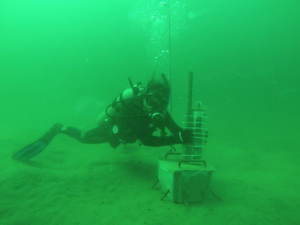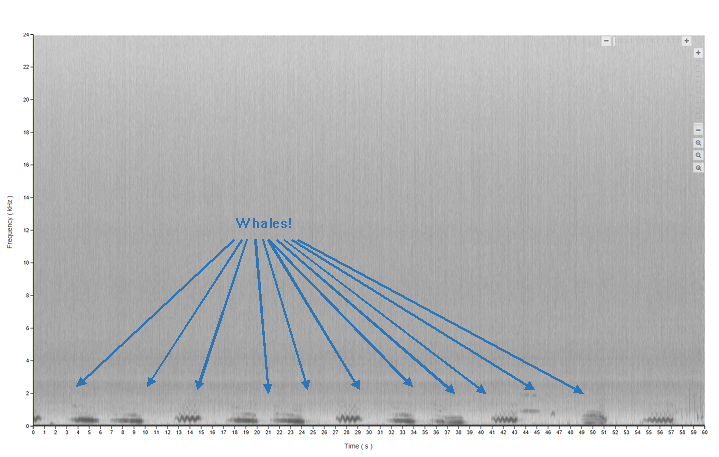Why and when male humpback whales sing? Students Shelby Rosten, Kate Ziegle, and Daniella McAree are taking upon the tasks of answer those questions. They are going over thousands of recordings collected with two underwater recorders called soundtraps (see photo) to document the singing behavior of Southern Hemisphere humpback whales wintering in the waters of Panama. Here is Shelby’s experience.
by Shelby Rosten
Our research is focused on the activity of humpback whales (Megaptera novaeangliae) off the Pacific coast of Panama. We want to find out at what time of day they are singing, when they arrive to Panama, and when they leave in the spring. We also want to investigate the impact of anthropogenic noise on whales’ behavior. We are becoming increasingly aware of the impact of man-made noise on animals. Especially in areas with a lot of boat traffic, low-frequency noises can potentially disrupt the vocalizations of whales since they use primarily low-frequency calls. To explore the impact of anthropogenic noise we are comparing the activity of whales at three sites of varying traffic and also analyzing the relationship between the presence of boats and the presence of whales. We are using passive acoustic monitoring data that was collected by Dr. May-Collado and her colleagues.
So far we have been working on processing our data and uploading it to ARBIMON to be analyzed l ater. We started off slowly but have finished our first site which was off the coast of Islas Secas! This site is unprotected but a lot of whales hang out there and we’ve seen songs in some of the recordings. This site has one month of data and we took one minute samples every five minutes for the duration of the monitoring. This was pretty time consuming as it took about an hour to sample each day. Now we have moved onto Coiba National Park. For this site we have about six months of data but in terms of processing we only have to trim the sound files. This means each day only takes about ten minutes so we can move through them much more quickly. Once we finish this site we will start on data from Islas Perlas. This data is a little more complicated to process because we have to stitch together short pieces of recordings into one minute samples.
ater. We started off slowly but have finished our first site which was off the coast of Islas Secas! This site is unprotected but a lot of whales hang out there and we’ve seen songs in some of the recordings. This site has one month of data and we took one minute samples every five minutes for the duration of the monitoring. This was pretty time consuming as it took about an hour to sample each day. Now we have moved onto Coiba National Park. For this site we have about six months of data but in terms of processing we only have to trim the sound files. This means each day only takes about ten minutes so we can move through them much more quickly. Once we finish this site we will start on data from Islas Perlas. This data is a little more complicated to process because we have to stitch together short pieces of recordings into one minute samples.
I think that so far we are making good progress with our data! The most frustrating thing, I think, has been finding time to come into the lab while also getting all of my homework done. Doing research is a really time consuming process, especially at this stage. I am grateful that I have two other people helping me because we can keep each other accountable and get through the data more quickly. I am excited to start analyzing the data because I have noticed some whale songs in a couple files which is really cool (see figure below)! I love whales and I eventually would like to study them and help to promote their conservation so I’m excited to see where this project goes and to contribute to the scientific community.
